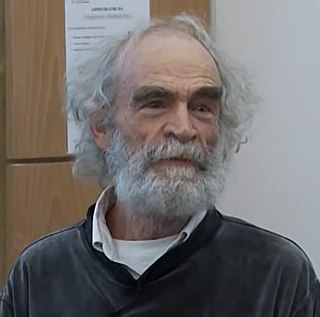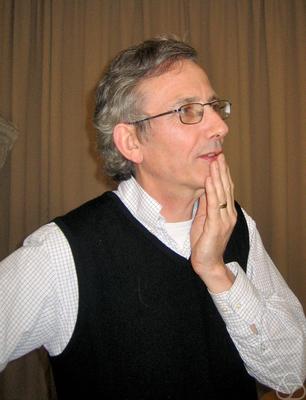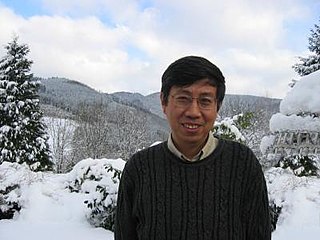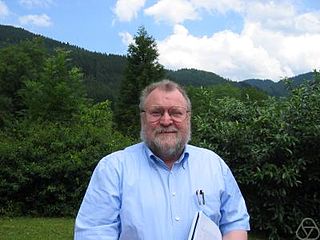
Symplectic geometry is a branch of differential geometry and differential topology that studies symplectic manifolds; that is, differentiable manifolds equipped with a closed, nondegenerate 2-form. Symplectic geometry has its origins in the Hamiltonian formulation of classical mechanics where the phase space of certain classical systems takes on the structure of a symplectic manifold.
In mathematics, a symplectomorphism or symplectic map is an isomorphism in the category of symplectic manifolds. In classical mechanics, a symplectomorphism represents a transformation of phase space that is volume-preserving and preserves the symplectic structure of phase space, and is called a canonical transformation.

Mikhael Leonidovich Gromov is a Russian-French mathematician known for his work in geometry, analysis and group theory. He is a permanent member of IHÉS in France and a professor of mathematics at New York University.

Sir Simon Kirwan Donaldson is an English mathematician known for his work on the topology of smooth (differentiable) four-dimensional manifolds, Donaldson–Thomas theory, and his contributions to Kähler geometry. He is currently a permanent member of the Simons Center for Geometry and Physics at Stony Brook University in New York, and a Professor in Pure Mathematics at Imperial College London.
In mathematics, specifically in topology and geometry, a pseudoholomorphic curve is a smooth map from a Riemann surface into an almost complex manifold that satisfies the Cauchy–Riemann equation. Introduced in 1985 by Mikhail Gromov, pseudoholomorphic curves have since revolutionized the study of symplectic manifolds. In particular, they lead to the Gromov–Witten invariants and Floer homology, and play a prominent role in string theory.
In mathematics, specifically in symplectic topology and algebraic geometry, Gromov–Witten (GW) invariants are rational numbers that, in certain situations, count pseudoholomorphic curves meeting prescribed conditions in a given symplectic manifold. The GW invariants may be packaged as a homology or cohomology class in an appropriate space, or as the deformed cup product of quantum cohomology. These invariants have been used to distinguish symplectic manifolds that were previously indistinguishable. They also play a crucial role in closed type IIA string theory. They are named after Mikhail Gromov and Edward Witten.
In mathematics, Floer homology is a tool for studying symplectic geometry and low-dimensional topology. Floer homology is a novel invariant that arises as an infinite-dimensional analogue of finite-dimensional Morse homology. Andreas Floer introduced the first version of Floer homology, now called Lagrangian Floer homology, in his proof of the Arnold conjecture in symplectic geometry. Floer also developed a closely related theory for Lagrangian submanifolds of a symplectic manifold. A third construction, also due to Floer, associates homology groups to closed three-dimensional manifolds using the Yang–Mills functional. These constructions and their descendants play a fundamental role in current investigations into the topology of symplectic and contact manifolds as well as (smooth) three- and four-dimensional manifolds.

Dusa McDuff FRS CorrFRSE is an English mathematician who works on symplectic geometry. She was the first recipient of the Ruth Lyttle Satter Prize in Mathematics, was a Noether Lecturer, and is a Fellow of the Royal Society. She is currently the Helen Lyttle Kimmel '42 Professor of Mathematics at Barnard College.
In mathematics, the Weinstein conjecture refers to a general existence problem for periodic orbits of Hamiltonian or Reeb vector flows. More specifically, the conjecture claims that on a compact contact manifold, its Reeb vector field should carry at least one periodic orbit.

Tian Gang is a Chinese mathematician. He is a professor of mathematics at Peking University and Higgins Professor Emeritus at Princeton University. He is known for contributions to the mathematical fields of Kähler geometry, Gromov-Witten theory, and geometric analysis.

Katrin Wehrheim is an associate professor of mathematics at the University of California, Berkeley. Their research centers around symplectic topology and gauge theory. They are known for their work on pseudoholomorphic quilts. With Dusa McDuff, they have challenged the foundational rigor of a classic proof in symplectic geometry.
Victor William Guillemin is an American mathematician working in the field of symplectic geometry, who has also made contributions to the fields of microlocal analysis, spectral theory, and mathematical physics. He is a tenured Professor in the Department of Mathematics at the Massachusetts Institute of Technology. His uncle Ernst Guillemin was a Professor of Electrical Engineering and Computer Science (EECS) at MIT, and his daughter Karen Guillemin is a Professor of Biology at the University of Oregon.
In mathematics, more precisely in symplectic geometry, a hypersurface of a symplectic manifold is said to be of contact type if there is 1-form such that and is a contact manifold, where is the natural inclusion. The terminology was first coined by Alan Weinstein.
János Kollár is a Hungarian mathematician, specializing in algebraic geometry.

Eugene Trubowitz is an American mathematician who studies analysis and mathematical physics. He is a Global Professor of Mathematics at New York University Abu Dhabi.

Eduard J. Zehnder is a Swiss mathematician, considered one of the founders of symplectic topology.
In mathematics, especially in topology, a Kuranishi structure is a smooth analogue of scheme structure. If a topological space is endowed with a Kuranishi structure, then locally it can be identified with the zero set of a smooth map , or the quotient of such a zero set by a finite group. Kuranishi structures were introduced by Japanese mathematicians Kenji Fukaya and Kaoru Ono in the study of Gromov–Witten invariants and Floer homology in symplectic geometry, and were named after Masatake Kuranishi.

Ralph Louis Cohen is an American mathematician, specializing in algebraic topology and differential topology.
François Lalonde is a Canadian mathematician, specializing in symplectic geometry and symplectic topology.
Ivan Smith is a British mathematician who deals with symplectic manifolds and their interaction with algebraic geometry, low-dimensional topology, and dynamics. He is a professor at the University of Cambridge.










